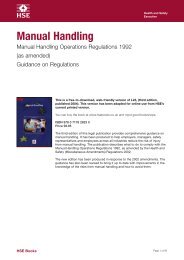Making Companies Safe - what works? (CCA ... - Unite the Union
Making Companies Safe - what works? (CCA ... - Unite the Union
Making Companies Safe - what works? (CCA ... - Unite the Union
You also want an ePaper? Increase the reach of your titles
YUMPU automatically turns print PDFs into web optimized ePapers that Google loves.
with… O<strong>the</strong>r studies found that while employers fulfilled some aspects of <strong>the</strong><br />
regulations, <strong>the</strong>y often did not take <strong>the</strong> required comprehensive action.” 30<br />
Hillage et al. specifically cite studies by Swan et al. (1998) and Lancaster et al. (2001), to<br />
support <strong>the</strong>se conclusions. For instance, Swan et al. found that while <strong>the</strong>re was a high<br />
general awareness of Control of Substances Hazardous to Health (COSHH) Regulations 1988,<br />
<strong>the</strong>re was low compliance with Schedule 9 and <strong>the</strong> Approved Code of Practive (AcoP). O<strong>the</strong>r<br />
studies similarly demonstrate that even where employers are aware of regulations, compliance<br />
is frequently incomplete and inadequate.<br />
This seems to be particularly true in relation to risk assessments, where findings from a<br />
number of studies suggest that <strong>the</strong>se are treated as a paper exercise. For instance, a study of<br />
causal factors in construction incidents by Loughborough University and UMIST found in<br />
relation to <strong>the</strong> 100 incidents studied that where risk assessments did exist <strong>the</strong>se were<br />
largely “a paper exercise”, often forming part of a method statement, which had a limited<br />
applicability to actual work circumstances. 31 And Thomson-MTS found amongst ten case<br />
study firms, that of <strong>the</strong> nine companies that had carried out a noise assessment as required by<br />
<strong>the</strong> Noise at Work Regulations, only four were adequate in terms of complying <strong>the</strong> legislation. 32<br />
Fur<strong>the</strong>r demonstration of <strong>the</strong> fact that compliance is often inadequate can be found in<br />
studies which show that, whilst organisations may technically comply with legislation, <strong>the</strong>y<br />
will often choose to apply <strong>the</strong> easiest and / or <strong>the</strong> cheapest control methods instead of those<br />
that are recommended by guidance or regulations as providing <strong>the</strong> most effective, and<br />
<strong>the</strong>refore preferable, means of controlling, reducing or eliminating risks. For instance, various<br />
studies have found that:<br />
• personal protective equipment (PPE) “is relied upon habitually as a substitute for risk<br />
elimination or reduction at source” in <strong>the</strong> construction industry; 33<br />
• companies that use chemicals are most likely to rely on PPE or use of process controls (for<br />
example ventilation systems) to control risks, ra<strong>the</strong>r than substitution of a hazardous<br />
substance or using it in a safer form; 34<br />
• most employers may provide workers with hearing protection but frequently fail to<br />
improve engineering control of noise because of <strong>the</strong> perceived costs involved. 35<br />
What stops employers translating knowledge into action?<br />
The studies reviewed provide ample evidence that even when employers possess knowledge<br />
and awareness of health hazards <strong>the</strong>y may still fail to take action to improve <strong>the</strong>ir OHS<br />
performance, or even to ensure compliance with regulatory requirements. Interview data from<br />
<strong>the</strong> UK indicates that <strong>the</strong> extent and adequacy of compliance with health and safety<br />
legislation is contingent upon numerous commercial and organisational factors. For<br />
instance, Mayhew and Quinlan found in <strong>the</strong> residential building sectors of Australia and<br />
Britain that self-employed builders thought that complying with legislation would make <strong>the</strong>m<br />
uncompetitive, and that breaches of OHS regulations were directly linked to attempts to<br />
minimise costs. 36 Similarly, Thomson-MTS found that senior management’s attitudes towards<br />
hearing conservation:<br />
“were influenced by overriding concerns with commercial factors: namely<br />
productivity, profit and public relations”. 37<br />
And whilst one or two senior managers saw hearing conservation as enhancing productivity<br />
and / or firm image, <strong>the</strong> majority stated that <strong>the</strong>y would not take fur<strong>the</strong>r action on limiting<br />
<strong>the</strong> risk of noise-induced hearing loss on <strong>the</strong> grounds that noise control measures would<br />
decrease productivity, and / or that such measures simply represented a cost with no obvious<br />
or immediate payback. 38<br />
What <strong>the</strong>se findings suggest is that even if <strong>the</strong> majority of employers believe that <strong>the</strong>y have<br />
a moral duty to protect <strong>the</strong> health and safety of <strong>the</strong>ir workforce, this conviction is not strong<br />
enough to overcome ei<strong>the</strong>r <strong>the</strong> imperatives of profit and production, or <strong>the</strong> distraction of<br />
o<strong>the</strong>r competing priorities.<br />
63
















